Overview
Oblique stretches are essential for enhancing core strength and stability, as they target the muscles crucial for trunk support and rotational movements. The article emphasizes that incorporating these stretches not only improves flexibility and reduces injury risk but also aligns with current fitness trends focused on effective abdominal training and injury prevention.
Introduction
In the quest for a stronger core, the often-overlooked oblique muscles play a pivotal role in enhancing stability and functionality. Nestled on the sides of the abdomen, these muscles not only facilitate essential movements like twisting and bending but also contribute to overall athletic performance and daily activities. Understanding their significance is crucial for anyone looking to improve their fitness regimen.
Recent studies shed light on the importance of targeted oblique training and stretching, revealing that a flexible and strong core is key to injury prevention and optimal physical performance. This article delves into the multifaceted benefits of oblique muscles, offering essential stretches and exercises to elevate core strength and stability, while emphasizing the importance of informed practices for safe and effective training.
Understanding the Role of Oblique Muscles in Core Strength
Located on the sides of the abdomen, the slanted fibers are essential to trunk strength and stability. Consisting of two main groups—the external and the internal—these structures aid in rotational movements, lateral bending, and the upkeep of posture. Their strength is essential not only for enhancing athletic performance but also for supporting everyday activities such as twisting and bending.
A well-developed group of side muscles, which can be strengthened through obliques stretches, plays a significant role in overall fitness, making it essential for individuals looking to enhance their abdominal strength to comprehend their function and significance. Recent studies emphasize the necessity for additional high-quality research, as pointed out by J.M.M., who observed that the level of evidence in current studies remains moderate, indicating an urgent need to enhance our understanding of these key muscle groups in relation to dynamics.
For instance, the case study titled 'Kettlebell Exercises and Muscle Activation' by Lyons et al. (2017) demonstrated that kettlebell swings elicited the greatest activation of the erector spinae, while kettlebell clean and snatch exercises showed higher external side muscle activation. This demonstrates the practical use of angled training in improving central strength. Furthermore, the study selection process for the research lasted three weeks, highlighting the thoroughness in evaluating strength dynamics.
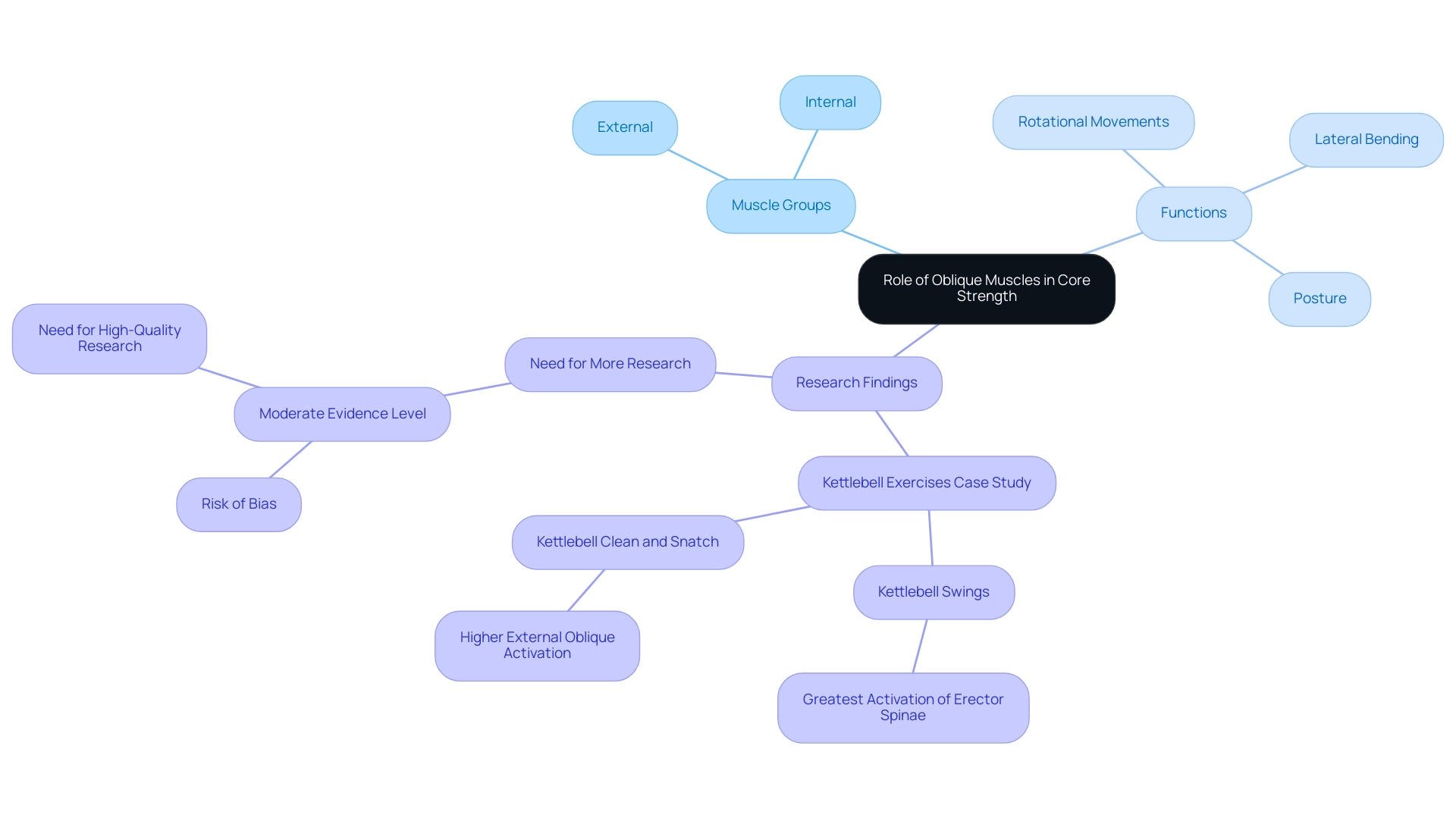
The Importance of Oblique Stretches for Core Stability
Including angled elongations in a workout regimen is essential for preserving midsection stability and overall movement effectiveness. By lengthening the oblique tissues, these obliques stretches enhance flexibility, significantly reducing the risk of strains and injuries. Recent studies indicate that a flexible center not only contributes to better athletic performance but is also crucial for individuals engaged in repetitive tasks or physical labor.
For instance, a randomized controlled trial by Hlaing et al. (2021) found that participants engaging in stability exercises showed significant improvements in proprioception, balance, and muscle thickness, with the CSE group demonstrating better outcomes compared to traditional strengthening exercises. This emphasizes the practical benefits of such routines.
Moreover, a study by McGill & Marshall (2012) involving participants aged 25.60 ± 3.40 years highlights that a flexible core is essential for injury prevention across various demographics. Physical therapists advocate for the significance of side stretches, noting that they can lead to better posture and a decreased likelihood of back pain. Eleftherios Kellis underscores this point, stating,
- 'A Comparison between Core Stability Exercises and Muscle Thickness Using Two Different Activation Maneuvers,' which highlights the need for targeted muscle engagement in stretching routines.
Overall, consistent obliques stretches of the side muscles are essential not only for avoiding injuries but also for enhancing trunk strength and stability.
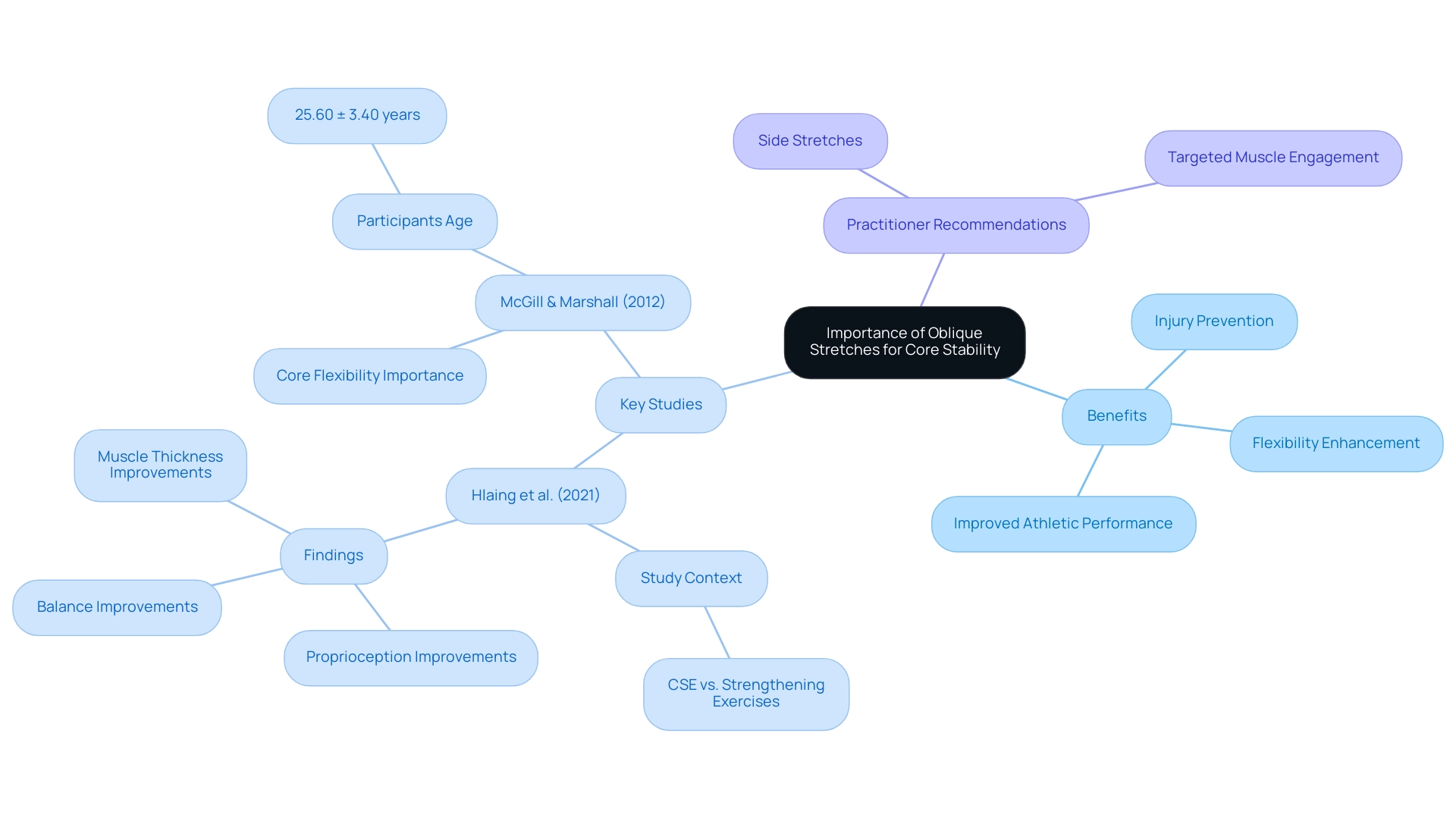
5 Essential Oblique Stretches to Enhance Core Strength
Here are five essential oblique exercises designed to enhance your core strength:
- Standing Side Stretch: Begin by standing tall with your feet shoulder-width apart. Lift one arm overhead, then lean to the opposite side, making sure you feel an extension along your side. Maintain this position for 15-30 seconds before switching sides. This stretch not only encourages flexibility but also aids in injury prevention, with studies showing that proper stretching can significantly lower the risk of strain. In fact, a fundamental stabilization program has shown a mean reduction in pain on the Visual Analogue Scale of 3.08, highlighting the effectiveness of such exercises.
- Seated Torso Twist: Sit on the floor with your legs extended in front of you. Bend one knee and place the foot outside the opposite thigh. Use your arm to gently twist your torso towards the bent knee, which activates the oblique muscles effectively. Hold for 15-30 seconds before switching sides. This exercise is especially advantageous for enhancing spinal mobility and stability, aligning with findings from Hlaing et al. that demonstrated significant enhancements in proprioception and balance through body stabilization exercises.
- Side-Lying Oblique Stretch: Lie on your side with your legs stacked. Extend your top arm overhead and gently pull it back while keeping your hips grounded. Hold this position for 15-30 seconds on each side. This segment is excellent for targeting the external muscles, improving both strength and flexibility.
- Cat-Cow Stretch: Start in an all-fours position. Inhale as you arch your back (cat position), and exhale as you round your spine (cow position). As you flow through these movements, incorporate a gentle twist to each side. Repeat for 5-10 cycles. This dynamic exercise is effective for warming up the torso and enhancing overall body awareness.
- Cobra Stretch with Twist: Lie face down with your hands placed under your shoulders. Push your upper body up into a cobra position, then gently twist your torso to one side, glancing over your shoulder. Hold for 15-30 seconds before switching sides. This exercise not only focuses on the side abdominal muscles but also encourages spinal extension and flexibility. As Aukuthota et al. note, additional information on the principles guiding core stabilization exercises can enhance understanding of the significance of including lateral stretches into fitness routines.
Including these stretches in your regimen can significantly improve core strength and overall fitness, aligning with current trends in exercise programs focused on injury prevention and muscle activation.
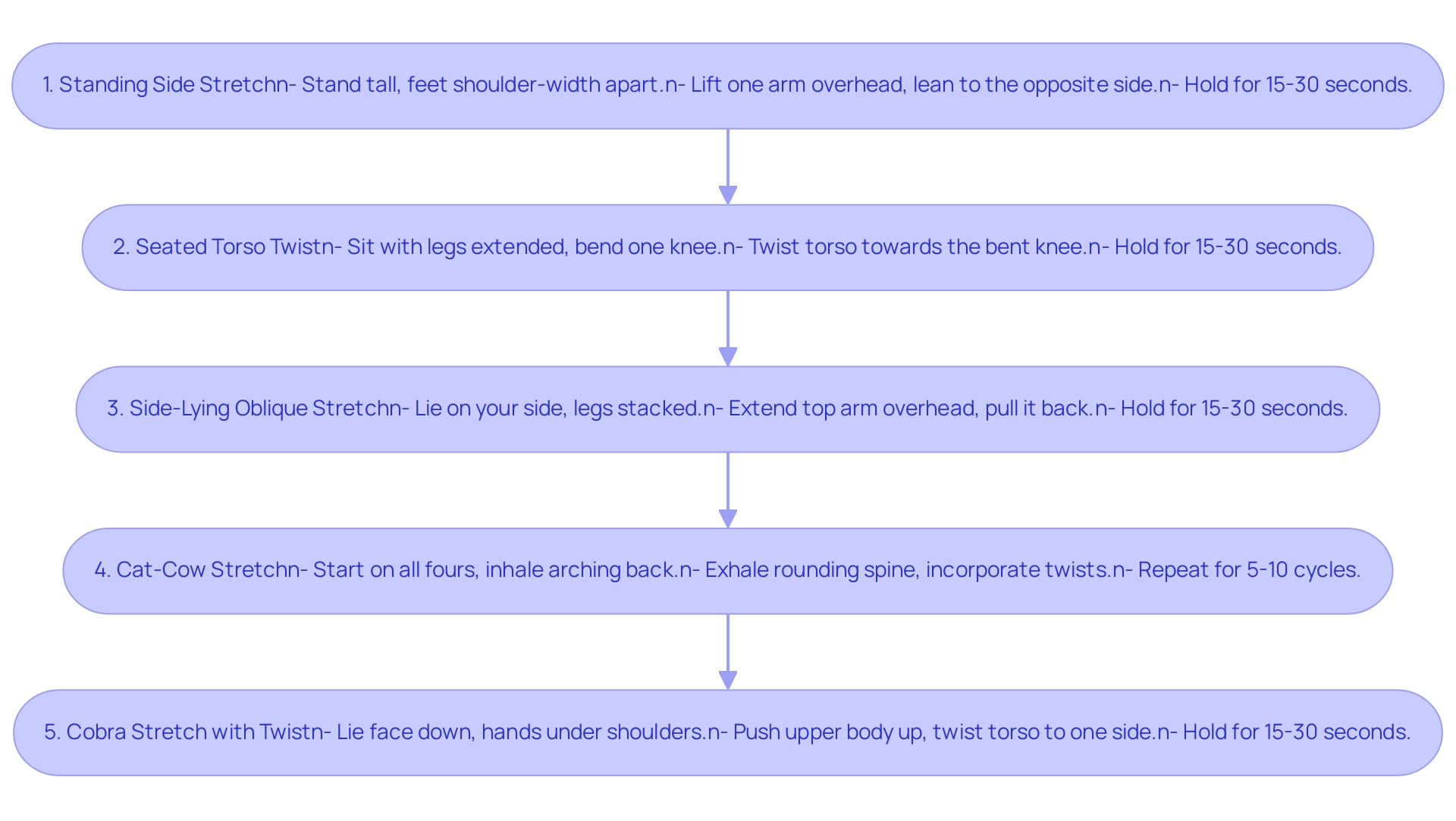
Complementary Exercises for Strengthening the Obliques
To effectively enhance your lateral strength, integrating these complementary exercises into your routine can yield significant benefits:
- Russian Twists: This exercise involves sitting on the floor with your knees bent and leaning back slightly. By twisting your torso side to side and tapping the floor beside you, you engage the side abdominal muscles thoroughly. Studies show that exercises such as Russian twists engage both side and hip areas, making them useful for activation without any equipment. The research results emphasize that such movements significantly stimulate the external EO tissues, enhancing overall strength in the trunk.
- Plank with Hip Dips: Begin in a traditional plank position. From here, slowly dip your hips to one side, return to the center, and then dip to the opposite side. This movement not only focuses on the side abdominal area but also engages the entire core, enhancing stability and strength across various groups. According to the study, this type of dynamic movement correlates with enhanced activation patterns during obliques stretches.
- Side Plank: Position yourself on your side, lifting your body off the ground while balancing on one forearm and the side of your foot. Maintaining this position fortifies the side muscles and improves overall stability. This exercise has been acknowledged for its capacity to enhance activation patterns in the lateral region, as shown by recent studies, which discovered that holding a side plank notably stimulates the lateral area compared to other workouts.
- Bicycle Crunches: Lying on your back, bring your knees to a tabletop position. Alternate bringing your elbow to the opposite knee while extending the other leg. This dynamic movement is effective in targeting the side abdominal areas and has been shown to engage various core groups simultaneously. The study's analysis of muscle recruitment indicates that bicycle crunches are among the most effective obliques stretches for activating the obliques.
- Woodchoppers: Stand with your feet shoulder-width apart, holding a weight or medicine ball. Rotate your torso to bring the weight from above one shoulder down to the opposite hip, mimicking a chopping motion. This exercise not only engages the side muscles but also enhances functional strength, making it a versatile addition to any workout routine. The study's insights indicate that such rotational movements are essential for effectively developing diagonal strength.
Integrating these exercises can greatly enhance your central stability, as a meta-analysis has demonstrated that such training significantly boosts central strength and balance. The mean perceived exertion for exercises like the sitting march was measured at 9.2 (2.2) on the Borg Scale, indicating a substantial effort level required for effective engagement. As fitness trends keep changing, concentrating on efficient side exercises remains an essential element of thorough abdominal training. As the study concludes, 'Our findings can be used to help guide core stability training and rehabilitation, using a variety of Swiss ball and traditional abdominal exercises.
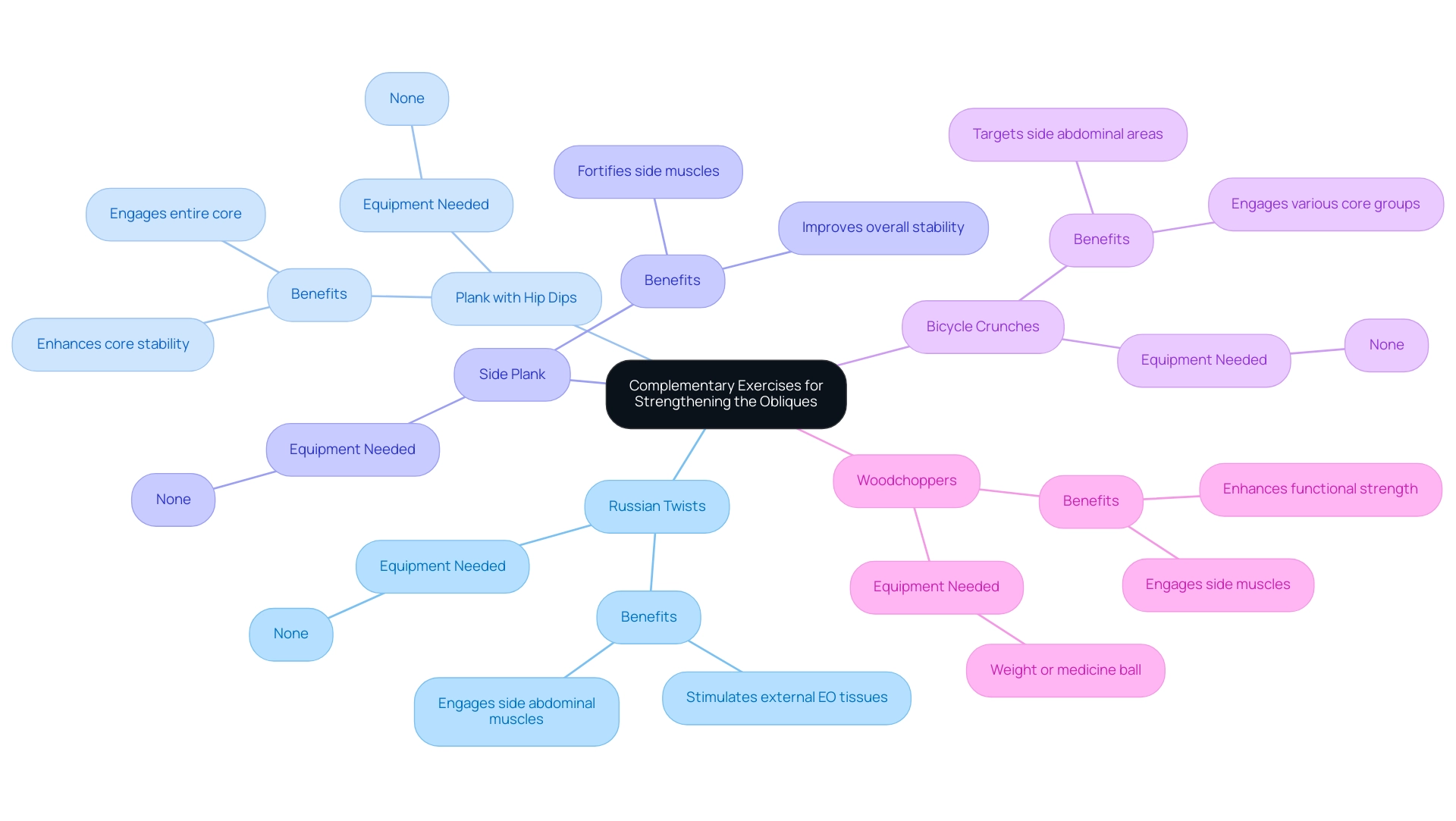
Tips for Safe and Effective Oblique Stretching
To maximize the benefits of oblique stretching while ensuring safety and effectiveness, consider the following essential tips:
- Warm Up First: Prioritize warming up your muscles through light cardio or dynamic movements. This step is crucial, as it prepares your body for the more intense static exercises that follow, significantly reducing the risk of injury.
- Listen to Your Body: It's vital to be attuned to your body's signals during stretching. If you experience any discomfort, it's crucial to ease off or adjust the exercise to prevent possible injuries.
- Breathe Deeply: Proper breathing enhances your stretching experience. Concentrate on inhaling deeply as you ready for each extension and exhaling as you deepen into the pose, fostering relaxation and effectiveness.
- Hold Each Position: Aim to maintain each position for a duration of 15-30 seconds. This practice allows your muscles to relax and lengthen properly, optimizing the benefits of each stretch.
- Incorporate Regularly: Make oblique stretching a consistent component of your fitness regimen. Regular practice not only enhances core strength and stability but also contributes to overall injury prevention.
Recent findings indicate that stretching practices were only partly aligned with evidence-based recommendations, highlighting the need for informed guidance in stretching techniques. In a related case study titled "Education and Supervision in Stretching," it was found that most respondents lacked formal education on proper stretching; however, women and national/international athletes reported higher levels of supervision. This underscores the importance of proper education and supervision in stretching practices.
As Desiree Baumer, a certified athletic trainer, emphasizes,
Be consistent with your stretches.
Incorporating these practices can lead to improved performance and reduced injury rates among athletes.
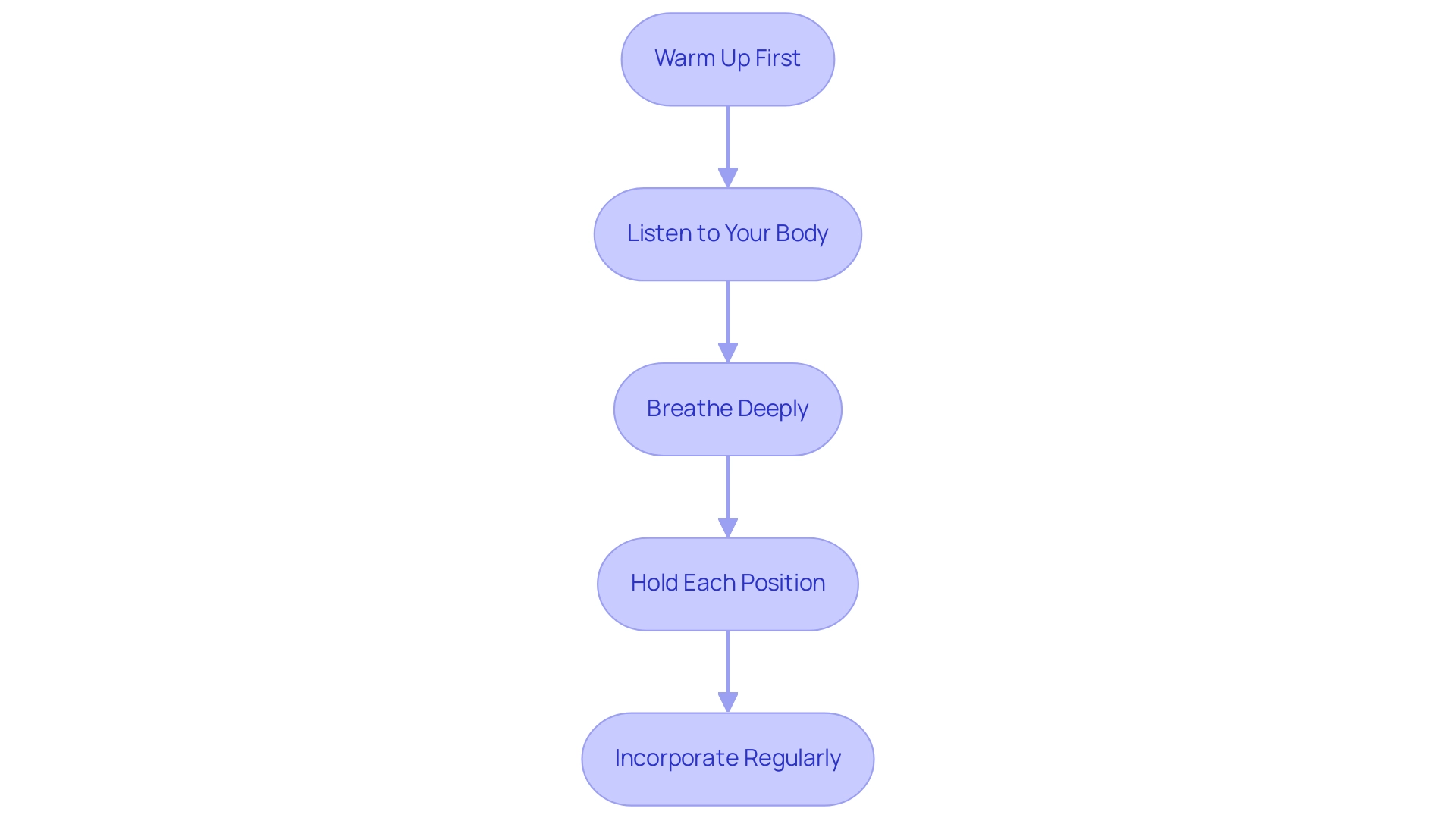
Conclusion
The significance of oblique muscles in enhancing core strength cannot be overstated. Positioned on the sides of the abdomen, these muscles are essential not only for athletic performance but also for everyday movements such as twisting and bending. As discussed, targeted training and stretching of the obliques contribute significantly to stability, flexibility, and injury prevention. Incorporating specific oblique stretches and strengthening exercises into a fitness routine is vital for maximizing core engagement and overall physical functionality.
Moreover, the article highlights practical strategies for effectively integrating oblique training into fitness regimens. From essential stretches like the Standing Side Stretch and Seated Torso Twist to exercises such as Russian Twists and Side Planks, each activity serves to enhance both strength and flexibility. These practices are supported by recent research, emphasizing the importance of informed training methods to achieve optimal results.
Ultimately, the key takeaway is that a strong and flexible core, bolstered by well-rounded oblique training, is foundational to both athletic prowess and daily functional movement. By prioritizing oblique exercises and stretches, individuals can not only improve their core stability but also reduce the risk of injuries, setting the stage for a healthier and more active lifestyle. Embracing these practices is a crucial step towards achieving comprehensive fitness and well-being.




